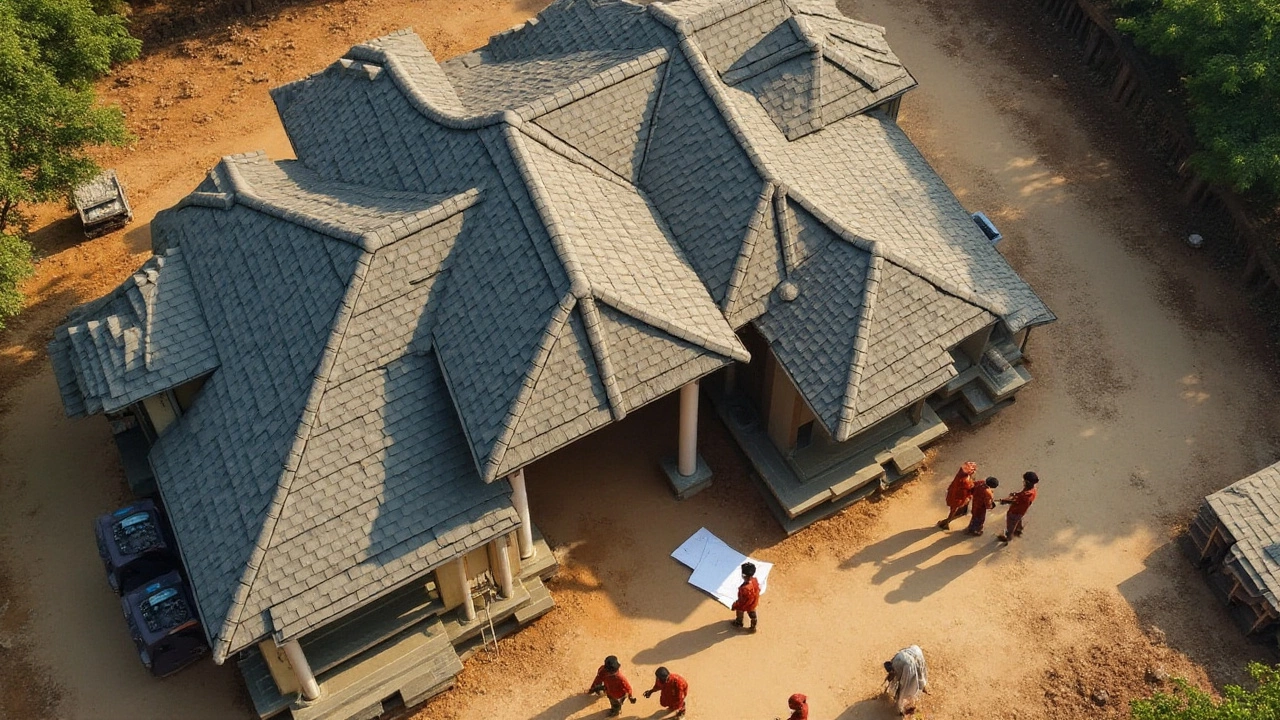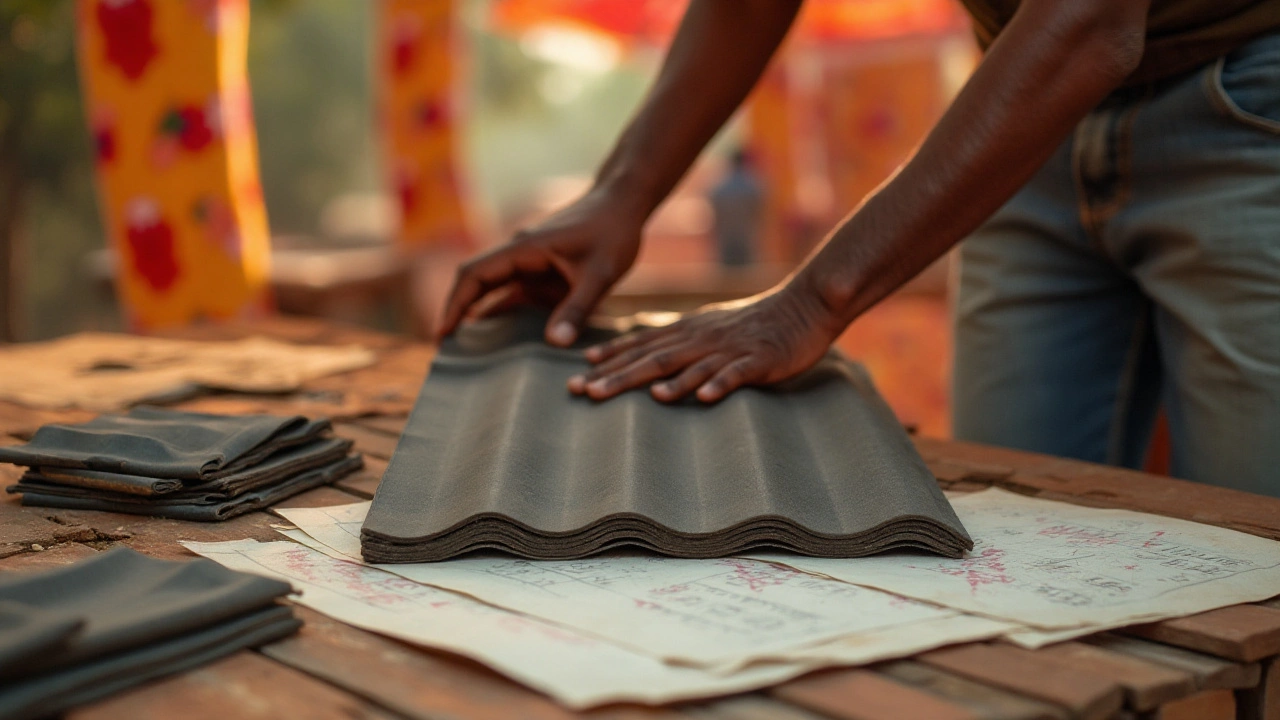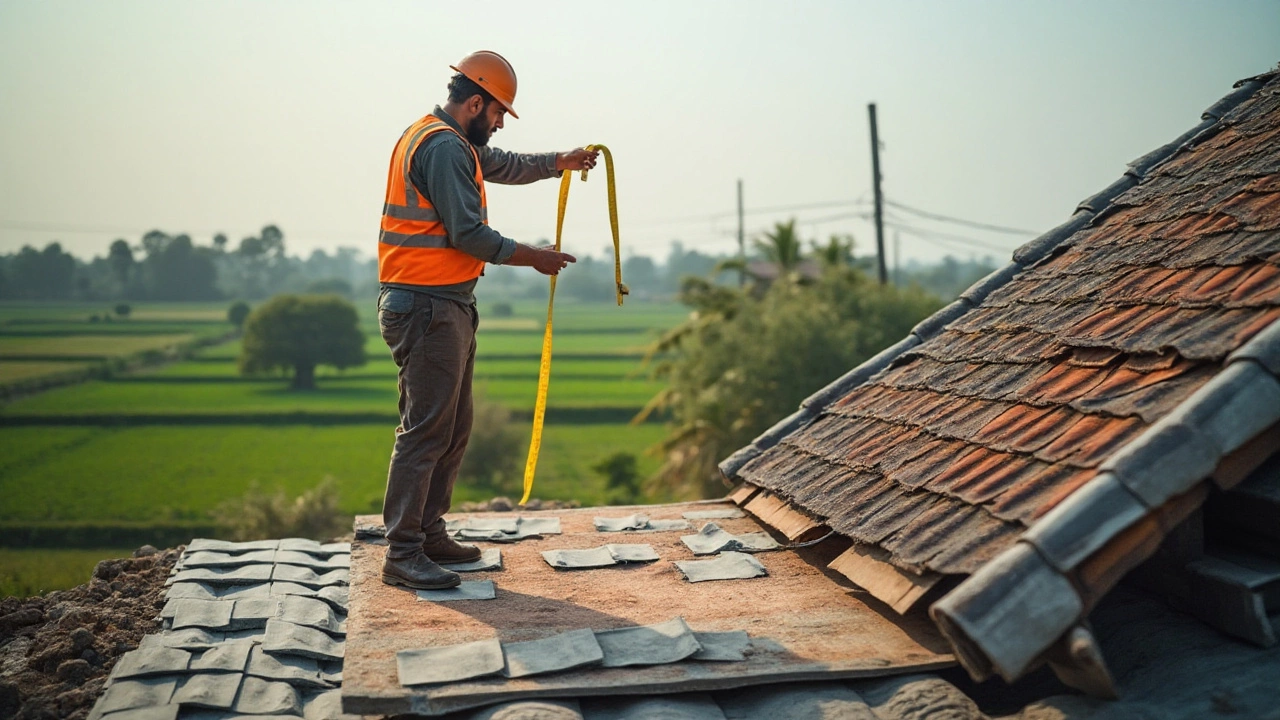When you're setting out on a roofing project, it’s not only about the looks but getting the size right to ensure complete protection and efficiency. If you own a 2000 sq ft house, calculating how much roofing you need is an important first step before making any purchases.
Understanding the unique features of your roof, like its pitch and any architectural complexities, plays a significant role. These factors may affect your material needs, along with the type of roofing materials you wish to use. Let’s delve into what influences roofing calculations and some handy tips to make the estimating process seamless.
- Understanding Roof Dimensions
- The Impact of Roof Slope
- Different Roofing Materials
- Calculating Roofing Materials
- Roof Pitch and Waste Factor
- Tips for Estimating Roofing Needs
Understanding Roof Dimensions
Deciphering the mystery of your home’s roofing dimensions is your first crucial step in ensuring a seamless roofing project. It’s often assumed that a 2000 sq ft house directly translates to a 2000 sq ft roof, but that’s more complex than it seems. The roof's area often exceeds the floor space due to various features and styles. Factors like the overhang and architectural elements, such as dormers or skylights, are significant contributors that can alter the dimensions. Surveys reveal that the actual roof size can vary by 10% to 15% compared to the base square footage of the house, illustrating that precision in measurement is vital.
To begin with, you must learn to read and understand the roof pitch. This angle determines how steep the roof is, altering not just its aesthetic but the square footage covered by the roof decking. Roofers use a pitch ratio, often noted as '4/12' or '6/12', indicating how many inches the roof rises per 12 inches horizontal. A higher pitch like 8/12 or 10/12 means you'll be dealing with more roof area, thus requiring more roofing material.
Adding more layers of complexity is the shape and style of your roof. While gable roofs are common and simple, with their two sloping sides, other styles like hip, mansard, or even more inventive designs can substantially impact the calculation for roofing materials. The many facets and heights of these styles increase the challenge of accurate measurement. Experts often suggest hiring a professional to prepare precise measurements since any error could result in a costly overestimation or underestimated shortage of materials. Some well-experienced roofers swear by using drones to measure and photograph roofs, adding a modern edge over traditional measuring tapes.
According to Roofing Contractor Magazine, "In a world where accuracy is paramount, technology provides the edge, saving time and reducing waste."
When it comes to mapping out roof dimensions, one cannot ignore the practical aspects of preparing their house for the task. Whether you’re planning to tackle the project yourself or with professional assistance, fashioning a plan that includes not just the tools but also weather considerations and safety precautions is paramount. Collecting accurate data is the bedrock upon which all future calculations rest.
Keep these insights close: A successful roofing project always starts with understanding the dimensions and peculiarities of your roof, not just its total surface area. The better grasp you have, the smoother your choice of materials and implementation will be. This small understanding significantly impacts your roofing estimate and gives your household reliable shelter, without a hitch. Let accuracy and preparation lay the groundwork for your construction triumph.
The Impact of Roof Slope
When considering roofing calculation needs for your home, the slope of the roof presents an unsuspected yet significant influence. Known as the pitch, this angle not only determines the architectural design but also affects the volume of material required. For a 2000 sq ft house, a steeper slope means more surface area, which in turn alters the amount of roofing needed. Roof slope is measured using a ratio that expresses how many inches the roof rises vertically for every 12 inches of horizontal run. Most residential roofs fall between a modest 4:12 to a steeper 9:12 slope. The steeper the slope, the higher the requirement for shingles or sheets, as more layering occurs to achieve optimal coverage. This factor ties directly to the cost and time dedicated to the project.
A steep slope often provides better drainage and snow shedding, making it ideal for climates with heavy rainfall or snowfall. It also offers an aesthetic appeal that some homeowners prefer, believing the height and angles contribute to a classic, timeless look. However, it comes at a cost. As the slope increases, so does the complexity of installation, potentially increasing labor charges. Because of this, contractors have to be adept at working with inclines and securing safety measures to handle the challenges steep roofs pose. It's worth noting that historical records reveal roofing styles adapted heavily to regional weather patterns, demonstrated by the dramatic pitches of Scandinavian rooftops designed to combat snow loads.
"A well-designed roof should aim to meet the unique needs of its environment," says architectural expert Jonathan Waterson. "The balance between aesthetic and function is critical—alongside knowing how roof pitch can impact the broader structural integrity."
In terms of roofing estimate preparation, cutting accuracy down to the nearest shingle is impractical. Waste factor must also be included. A steep pitch typically demands a higher waste factor due to more cuts and overlaps. Builders often recommend adding an additional 10% to 15% to ensure coverage, especially on complex roof designs. The process of estimating such needs becomes easier with digital tools available today. Using interactive calculators, homeowners and professionals can input dimensions and slope to get an accurate reading of material requirements. Roof size becomes an amalgamation of precise measurements, pitch considerations, and expertise, a trifecta that produces an equation aligning affordability with protection.
In summation, acknowledging the roof’s pitch is fundamental when determining how much roofing material you'll need for a specific project size. This understanding safeguards against insufficient coverage while optimizing budget expenditure. It's a critical component that not only affects immediate construction but also impacts longer-term maintenance needs. Experienced contractors know this, advocating for early, thorough assessments to prevent unwanted surprises later on.

Different Roofing Materials
When it comes to sheltering your home, the choice of roofing materials is crucial. Not only do they affect the aesthetic appeal of your house, but they also influence durability, cost, and environmental impact. Roofing materials like asphalt shingles, metal sheets, clay tiles, and cedar shakes have long been the staple of 21st-century roofing options.
Asphalt shingles are the most popular choice among homeowners because of their affordability and easy installation. These shingles are versatile, coming in a broad selection of colors and textures, lending an adaptable style that could suit nearly any home design. Despite their low cost, they're durable enough to withstand most weather conditions, often lasting 20 to 30 years. However, asphalt shingles are susceptible to damage by high winds and can develop mold in damp environments, requiring vigilant maintenance.
Metal roofing has seen a surge in popularity because of its moisture-resistant quality and longevity, often sustaining between 40 to 70 years or more. It reflects sunlight, enhancing energy efficiency by reducing cooling costs. Metal roofs can mimic other materials like shingle, slate, and tile, allowing homeowners to enjoy the benefits of metal while retaining their preferred look. However, upfront costs are generally higher, and the noise during heavy rain or hail might require additional sound deadening insulation.
Clay and concrete tiles provide a distinct and long-lasting roof that is both fire-resistant and environmentally friendly. Known for their Mediterranean charm, clay tiles can last a century if properly installed and cared for. A great option for sustainability, clay doesn’t degrade over time. Concrete tiles, often less expensive than clay, are also fire-resistant but offer a slightly shorter lifespan. Both are heavy materials, necessitating reinforced roofing support to bear their weight effectively.
"The choice of roofing material should not solely depend on cost but also performance, aesthetics, and longevity," notes Jeanne Schwartz, a well-regarded architect.Cedar shakes offer aesthetic appeal with their natural beauty and are more eco-friendly than synthetic materials, often harvested from sustainable forests. They provide natural insulation, keeping homes cooler in summer and warmer in winter, which can reduce energy bills. However, they require more maintenance to prevent issues like moss and mildew growth, especially in humid, rainy climates.
Homeowners should not overlook new and innovative roofing materials like solar shingles, which offer the twin benefits of traditional shingles while generating electricity from sunlight. Though initially expensive, they can lower energy bills significantly over the years. Choosing the right roofing materials for your house involves considering factors unique to your situation, like climate, aesthetic preference, maintenance commitment, and budget.
Calculating Roofing Materials
Embarking on a roofing calculation journey may seem daunting at first glance, but a systematic approach can unravel the mystery and give you confidence in the process. To determine how much roofing is required for a 2000 sq ft home, it's crucial to assess your roof's roof size and dimensions, including any features like dormers or valleys. A basic understanding involves multiplying the length and width of each roof section to determine the area, and then summing these measurements. However, it doesn't stop there. Roof slope or the pitch—how steep or flat your roof is—alters the actual surface area that needs covering.
Let’s dive deeper: imagine balancing your way along the incline during a post-rain inspection. The steeper the pitch, the more surface area you'll encounter. This pitch is often measured as a ratio of vertical rise over a 12-inch horizontal span. For instance, a 6/12 pitch will rise six inches for every foot of horizontal distance. This slope can significantly influence how much roofing material you require. Sometimes, it might appear that you've over-ordered just to catch waste and miscalculations stemming from this very geometry. Experts often recommend multiplying your area by a 'roofing slope multiplier' to get the actual material coverage needed.
Understanding the right roofing estimate involves acknowledging another factor known as the 'waste factor'. Fact is, all roofs aren't created equal—some feature complex designs that lead to more material cuts and, consequently, more waste. Experienced installers typically add a waste factor of around 10% for simple gable roofs, potentially rising to 15% or more for intricate designs involving angles and skylights. Layer this on top of your calculated roof area to ensure you aren't caught short halfway through your project. This proactive approach helps avoid delays and unnecessary stress.
"The measure of trueness in measurements can never be too trivial, especially when it’s your nest you are protecting," says renowned roofing expert Jason Dominguez.
As roofs age, they evolve alongside their components. Whether you plan to use asphalt shingles—often the easiest in DIY endeavors—or metal sheets, having excess instead of scarcity means sidestepping unexpected weather interruptions. Notably, roofing materials might come in bundles or squares, so understanding these units is key. Typically, a bundle covers about 33.3 sq ft, with three bundles equating to a roofing square. For our context of a 2000 sq ft house, accounting for slope and waste, expect at least 22 squares.
Navigating the world of roofing doesn't just call for knowledge but also intuition. Letting the roof lead your logic, you’ll find it guiding you from misconceptions to mastery over its needs. Tables and charts, like the one below, can also aid in visualization:
| Pitch Type | Multiplier |
|---|---|
| 4/12 - 5/12 | 1.054 |
| 6/12 | 1.118 |
| 7/12 | 1.202 |

Roof Pitch and Waste Factor
When it comes to determining roof size, two crucial aspects often come into play: the roof pitch and the waste factor. While they might seem like mere mathematical components in the broader scheme of roofing, their significance cannot be overstated. The roof pitch, or its steepness, is not just a stylistic choice but impacts the kind of materials you'll need. For instance, a steeper pitch often requires more materials due to its greater surface area, despite the house's flat square footage seeming straightforward at first glance.
Roof pitch measures the incline or steepness of a roof, typically given as a ratio of vertical rise to horizontal run. It is expressed as a fraction, such as 4/12 or 8/12, indicating the inches of vertical rise for every 12 inches of horizontal run. A higher pitch means a roof is steeper, often adding a dramatic flair to homes but also complicating the construction process. The higher the pitch, the more roofing materials you might need, which should be factored into your calculations. Consider the standard roof pitch when planning; a roof with a 6/12 pitch covers more area and involves more material than a flat one.
The waste factor is equally crucial and typically involves adding an extra percentage to account for materials wasted due to cutting, fitting, accidents, and peculiar roof features. Estimating the right waste factor often hinges on your home's roof complexities, such as valleys, hips, and dormers, which require trimming shingles to fit properly. A basic roof might only require a waste factor as low as 5%, but those with more intricate designs can see this number climb up to 15% or higher. Imagine underestimating this factor while ordering materials and running short mid-project—it leads to delays, extra costs, and possibly even mismatched shingles if the batch differs slightly.
"About 10% waste is typical for a gable roof, while a hip roof will need approximately 15% waste," says John, a roofing expert from Quality Roofers Magazine. "Of course, the more complex the roof’s features, the more you should consider increasing this percentage."
Choosing the right roofing material also intertwines with understanding pitch and waste. Some materials work better on certain pitches—shingles, for instance, dominate in steeper slopes, while metal roofs often provide efficiency for flatter designs. Also, remember that some materials are more susceptible to waste than others, with clay tiles usually generating more waste when compared to other options. Waste percentages can depend considerably on whether you're utilizing materials like shingles or opting for something more unique such as metal sheets or eco-roofs, each presenting their unique set of challenges and calculations.
To make this easier, consider a typical example for calculation. Suppose your home has a rectangular gable roof with dimensions amounting to 2,000 sq ft of roofing area. A 6/12 pitch might mean you're covering at least 2,300 sq ft of actual roof space. Adding a conservative waste factor of 10% increases your required materials to about 2,530 sq ft to ensure you have ample resources for covering unpredicted waste during installation.
Therefore, a solid understanding of roof pitch and waste factor can guide you towards smarter planning and budgeting decisions. Get ready to use your newfound knowledge as you embark on the journey to finding just the right amount and type of material needed for your 2000 sq ft home. Best of luck in your roofing endeavor, ensuring that every calculated effort pays off in establishing that perfect shelter over your build.
Tips for Estimating Roofing Needs
Embarking on a roofing project for a 2000 sq ft home can be an exciting yet daunting task. It’s crucial to gather accurate information about your roof's dimensions and other key factors to avoid costly mistakes. The first step is getting to know the architecture of your home. Different roof styles and pitches will significantly affect the quantity of roofing material required. A steeper roof means more surface area and hence, more materials. Understanding this will help prevent over-purchase or, worse, coming up short when you’re halfway done with the project.
The impact of waste factor should not be underestimated when estimating roofing needs. Waste factor accounts for the material overlooked due to trimming and fitting around dormers, vents, and other architectural features. A well-calculated waste factor, generally between 10-15%, ensures you have enough material without unnecessary surplus. For instance, if your calculations determine that you need 30 squares of shingles, adding a 10% waste factor translates to 33 squares. This technique helps you cover complex roof areas without unexpected trips to the supply store.
Next, consider using digital tools to simplify the process. Today’s technology provides online calculators designed for roof size estimation. These tools can be highly effective in delivering accurate estimates quickly. By inputting roof dimensions, pitch, and material preference, you can swiftly determine what you need.
"Technology isn’t just for the tech-savvy. With online roof calculators, anyone can achieve accuracy when estimating materials," states architectural expert John Templar.Such resources reduce the guesswork involved in traditional methods.
Alongside tools, don’t forget the importance of consulting experienced roofers or contractors. While DIY projects are rewarding, professional advice ensures safety and precision in your material estimates. Contractors often bring insights from years of experience, pointing out aspects you might overlook. Their advice can be pivotal, especially in regions with extreme weather, affecting your choice and quantity of roofing materials. Don’t hesitate to reach out and make informed decisions based on expert guidance.
Lastly, pay attention to seasonal factors. Roofing projects are best planned when the weather is favorable, typically in spring or fall. Weather conditions can affect not only the roof installation process but also the amount of wear-and-tear on materials. It's prudent to schedule your project at a time that ensures high-quality, long-lasting results. Keep in mind these seasonal changes while placing your materials order.

Written by Fletcher Abernathy
View all posts by: Fletcher Abernathy